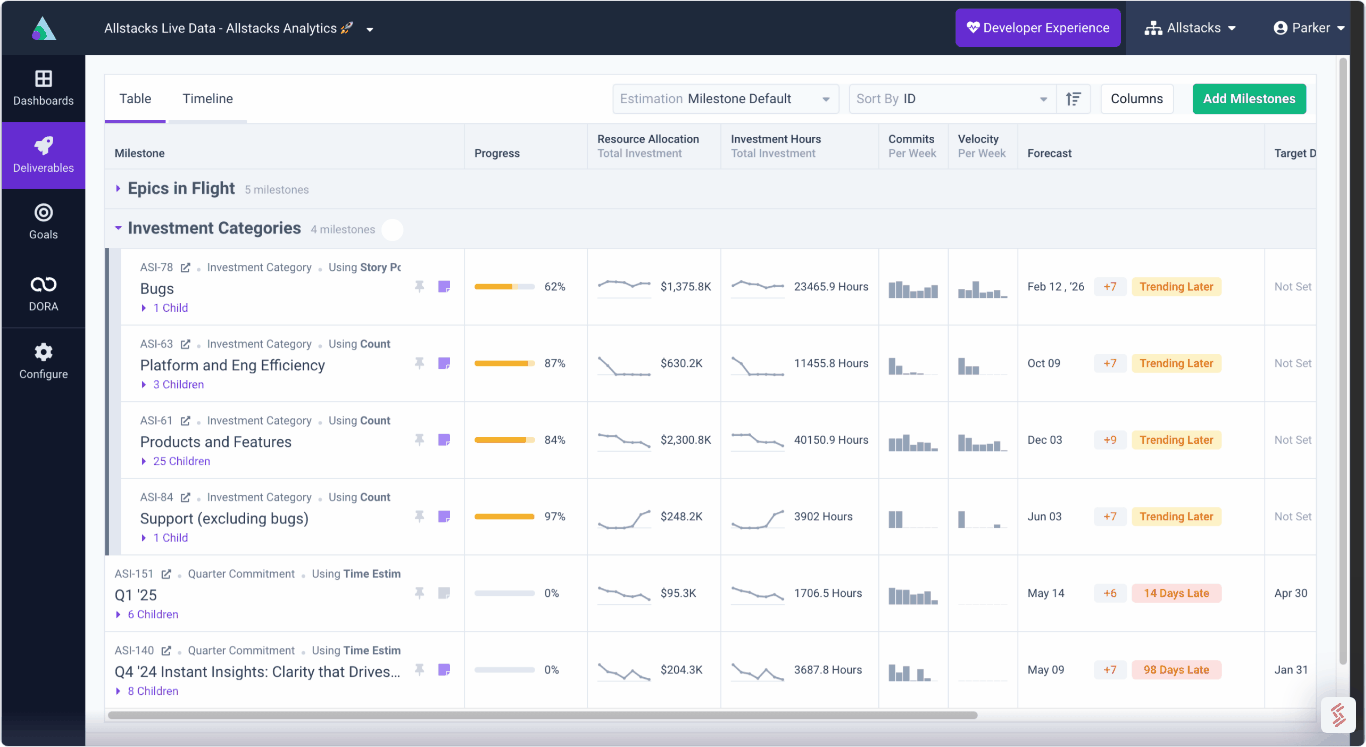.png)
Software Engineering Intelligence
-
Intelligence Engine
On-demand exhaustive AI-analysis
-
Engineering Investment
Complete visibility into time & dollars spent
-
360º Insights
Create meaningful reports and dashboards
-
Project Forecasting
Track and forecast all deliverables
DevEx
-
Developer Surveys
Create and share developer surveys
Software Capitalization
-
R&D Capitalization Reporting
Align and track development costs
Building a Highly Effective Agile Team Dashboard
This guide discusses best practices for designing exceptional Agile dashboards with metrics that generate real, actionable business value.

Key Takeaways:
- What is the value of an Agile team dashboard?
- What are some effective elements for Agile dashboards designs?
- The four steps to design an exceptional Agile dashboard for teams and stakeholders
- What are the practical team metrics to use?
- The top five Agile team metrics
- The five dimensions of SPACE metrics
Agile teams rely on dashboards to manage tasks and track work efficiently. The metrics included within team dashboards enable stakeholders to receive intuitive, at-a-glance, and detailed information to keep project leaders in the loop when managing project and team performance with added precision.
Agile teams rely on dashboards to gather and present valuable metrics and track work efficiently like DORA dashboards for holistic evaluation of an engineering organization. Dashboards provide practical information to make the best business decisions.
Designing a valuable dashboard is the first step to delivering practical metrics to team members, project leaders, and other key stakeholders. A well-designed Agile dashboard keeps the development team focused on project work and the project leaders on ensuring the team’s workflows through at optimum levels with less or no interruptions.
This guide discusses the best practices for designing exceptional Agile team dashboards with the right metrics that generate actionable business value.
What is the value of an Agile team dashboard?
The value of Agile team dashboards is that they amalgamate metrics that reflect the overall productivity and efficiency of a team. Measuring engineering productivity reflects whether the team meets, exceeds, or falls short of expectations. Savvy engineering leaders can use these metrics to identify and eliminate inefficient processes or procedures, improving team productivity.
Agile dashboards also include team-based details. For example, when engineering teams use a development tool like Jira, there are standard development team metrics that evaluate team performance (we’ll get to those later). Those metrics help to measure team progress to discover workflow issues, performance problems, or work progress bottlenecks.
Ready to get started? Let’s look at what a pragmatic Agile dashboard design with useful metrics looks like.
What are some effective elements for Agile dashboards?
Well-designed Agile dashboards present data for an at-a-glance analysis of the engineering team. They present data-based intelligence using data visualization to display actionable data and track engineering KPIs.
Project managers, team leaders, VPs of engineering, product managers, and other stakeholders need access to real-time data using an intuitive design that is easy to use and understand. Project leaders can use dashboard data to see variances between actual and expected metrics and take action to address common problems like delayed delivery or stale items in product review.
Dashboards provide access to KPIs and the detailed data behind them. The option to drill down and filter data provides a greater depth of analysis when needed.
4 steps to designing an exceptional Agile dashboard
- Understand the data stakeholders and project leaders need to analyze
Personalize content to the user, so the dashboard displays essential data for each individual based on their role
- Determine which KPIs to measure and display
Prioritize KPIs based on roles within the team
- Show data trends over time with filter tools
Gain valuable insight into progress over time - Prioritize data with a visual hierarchy
Present the highest priority team productivity metrics first so they are immediately seen and analyzed in context with the lower priority metrics.
What are the practical team metrics to use?
Unfortunately, some engineering metrics do not provide insight into a team’s working relationship or productivity. Here, we will discuss a few popular metrics for software development teams, including SPACE and DORA metrics.
Engineering teams often rely on development metrics as a proxy for measuring developer team efficacy. These metrics cut across Agile project management systems (like Scrum or Kanban), making them flexible enough to apply to variety of teams and projects. While they don’t necessarily answer the question, “Is my engineering team effective?”, they provide leading indicators for analyzing if the team will deliver on time and with quality.
5 common development metrics are:
- Velocity
Measures how fast the team works by calculating velocity based on how many story points the team completes in a sprint. Over time, velocity measures the average number of story points a team completes. - Cycle time
The time a team spends working on user stories or features from design to release. Helps to identify inefficiencies in work processes or procedures. - Defect ratio
Measures the number of defects coming from the team or project and the frequency at which they are successfully repaired. - Sprint burndown
Measures the time it takes for a team to complete work during a sprint or iteration. Helps to determine if the team is meeting its sprint completion goals. - Epic burndown
Epics are feature collections or user stories grouped into large feature sets. Measuring the Epic burndown tells stakeholders how much longer until the Epic’s features are completed.
SPACE metrics capture a 360-degree view of development team productivity. SPACE rejects the standard engineering practices that silo windows of individual performance to judge team productivity, instead measuring the broader factors that impact team productivity at the individual, team, and organizational levels.
The 5 dimensions of SPACE metrics are:
- Satisfaction and well-being
Measures how fulfilled team members are with their work, team relationship, tools, and company culture. - Performance
Measures team and individual velocity, quality, and business impact. - Activity
Counts the actions or output completed during sprints or iterations by the individual and the team.
- Communication and collaboration
Measures how well the team works together. Requires transparency and awareness of team member roles, tasks, team dynamics, and work task priorities. - Efficiency and flow
Measures how often a team member’s workflow gets interrupted by distractions, rework, non-useful meetings, or non-productive delays.
Look to Allstacks for professional development team metrics that provide insight into team productivity. Improve team productivity by leveraging SPACE metrics. Find out what Allstacks can do for your Agile team management with a free trial.
DORA stands for DevOps Research and Assessment. DORA metrics measure the work output of a team, including the tempo, rhythm, and responsiveness of the engineering organization to manage issues or work disruptions.
The 4 DORA metrics are:
- Software delivery lead time
Measures how long it takes for a commit to go into production.
- Deployment frequency
Measures the frequency with which the team deploys release code or commits release code.
- Mean time to restore or recovery (MTTR)
Measures the system downtime and how long it takes to get it back up and running, or for how long a defect impacts the customer and the time it takes to fix it.
- Change failure rate or percentage
Measures the number of defects within deployments over a defined period.
When designing an Agile dashboard, remember that the goal for measuring any metric is to improve the team and the quality of the product. Use those measurements to reduce waste in your engineering processes and ensure your team continues to improve over time.
Not sure where to start? Allstacks has DORA and SPACE dashboards ready to go. Just plug in your engineering tools like Jira, Bitbucket, and CircleCI to get started with our free trial.

